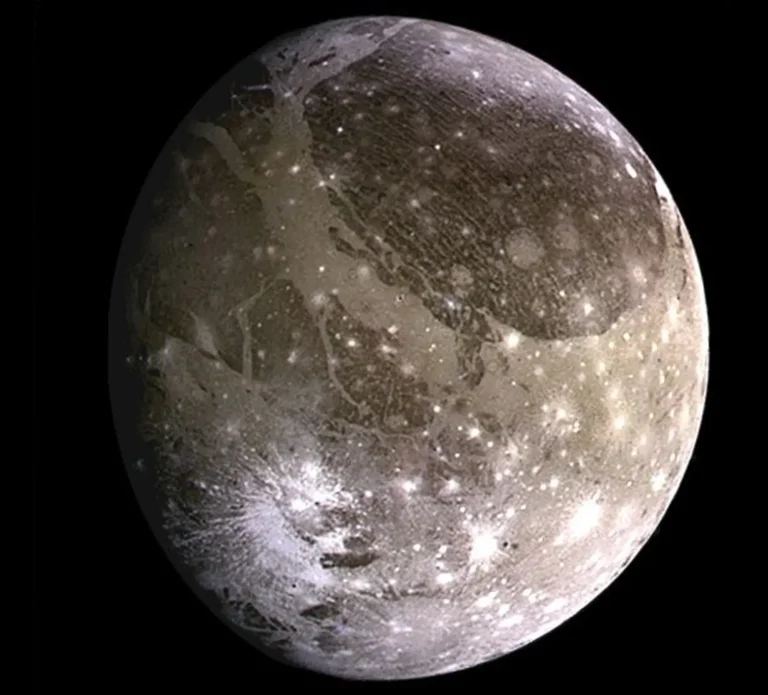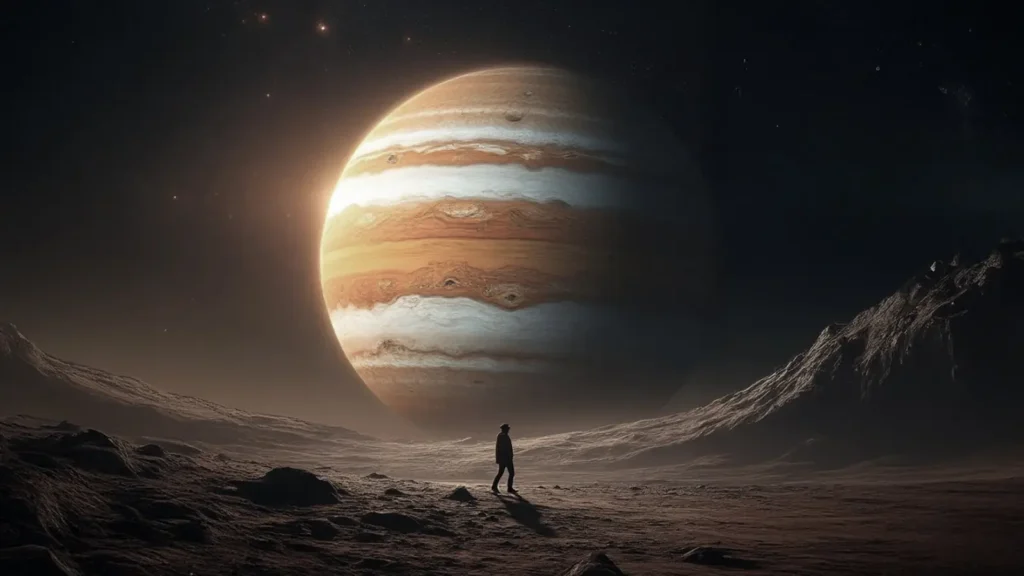Introduction: What is Ganymede?
Ganymede is the largest moon in the entire solar system and one of Jupiter’s 95 known moons. It is even bigger than the planet Mercury, making it a celestial object of great scientific interest. Ganymede is unique not only because of its size but also due to its magnetic field, geological activity, and potential subsurface ocean.

Quick Facts About Ganymede
- Diameter: 5,268 km (3,273 miles)
- Distance from Jupiter: ~1.07 million km (665,000 miles)
- Discovered by: Galileo Galilei in 1610
- Orbital Period: About 7.15 Earth days
- Surface Temperature: Around -160°C (-256°F)
- Interesting Fact: Ganymede is the only moon known to have its own magnetic field.
Composition and Structure of Ganymede
Ganymede is primarily made up of silicate rock and water ice. Scientists believe it has a metallic iron-nickel core, a rocky mantle, and a thick icy crust.
Beneath its surface, researchers suspect a liquid saltwater ocean, which might contain more water than all of Earth’s oceans combined. This subsurface ocean is one of the major reasons Ganymede is a target for astrobiological studies.
Surface Features and Geography
Ganymede’s surface is a mix of dark, ancient regions filled with impact craters and lighter, younger areas with grooves and ridges likely formed by tectonic activity. These features suggest that Ganymede has experienced geological resurfacing, possibly due to tidal heating from Jupiter’s gravity.
Key surface features include:
- Grooved terrain caused by stretching and faulting.
- Bright icy regions from resurfacing events
- Craters that date back billions of years.
Ganymede’s Magnetic Field
One of the most unique aspects of Ganymede is that it has its own magnetic field, unlike any other moon in the solar system. This field creates auroras around the moon’s polar regions, which interact with Jupiter’s enormous magnetosphere.
Exploration Missions to Ganymede
Over the past few decades, several spacecraft have visited or flown by Ganymede, giving us important insights into its structure, surface, and atmosphere. These missions have progressively enhanced our understanding of this enormous Jovian moon, laying the foundation for future, more focused explorations.
Key Missions
- Voyager 1 and 2 (1979): Captured the first detailed images.
- Galileo Orbiter (1995–2003): Performed multiple flybys.
- Juno (2021 flyby): Captured high-resolution images.
- JUICE (2023–2034): Will orbit and study Ganymede in depth.
Is There Life on Ganymede?
Although there is no direct evidence of life, Ganymede’s subsurface ocean may contain the right conditions to support microbial life. The presence of water, heat, and the necessary chemical ingredients makes it an exciting candidate in the search for extraterrestrial life.
Why is Ganymede Important?
Ganymede is significant because:
- It challenges the definition of what a moon can be.
- It may host a habitable environment beneath its icy shell.
- Its magnetic field offers clues about internal dynamo processes.
- It’s a prime target for future missions searching for signs of life.
FAQs About Jupiter Being a Failed Star
Is Ganymede bigger than Earth?
No, but Ganymede is larger than Mercury and all other moons in the solar system.
Can Ganymede support life?
Possibly. Its subsurface ocean could harbor microbial life, but this has yet to be confirmed.
Why does Ganymede have a magnetic field?
It likely comes from a liquid iron core, similar to Earth’s internal dynamo effect.
When was Ganymede discovered?
Ganymede was discovered in 1610 by Galileo Galilei, along with three other Galilean moons.
What is the JUICE mission?
JUICE (JUpiter ICy moons Explorer) is a European Space Agency mission set to explore Ganymede in detail around 2034.
Conclusion
Ganymede is more than just a moon—it’s a world in its own right. With its gigantic size, underground ocean, and magnetic field, it holds many clues to understanding our solar system and the potential for life beyond Earth. Future missions like JUICE will reveal even more about this fascinating celestial body.
Read Similar Articles


